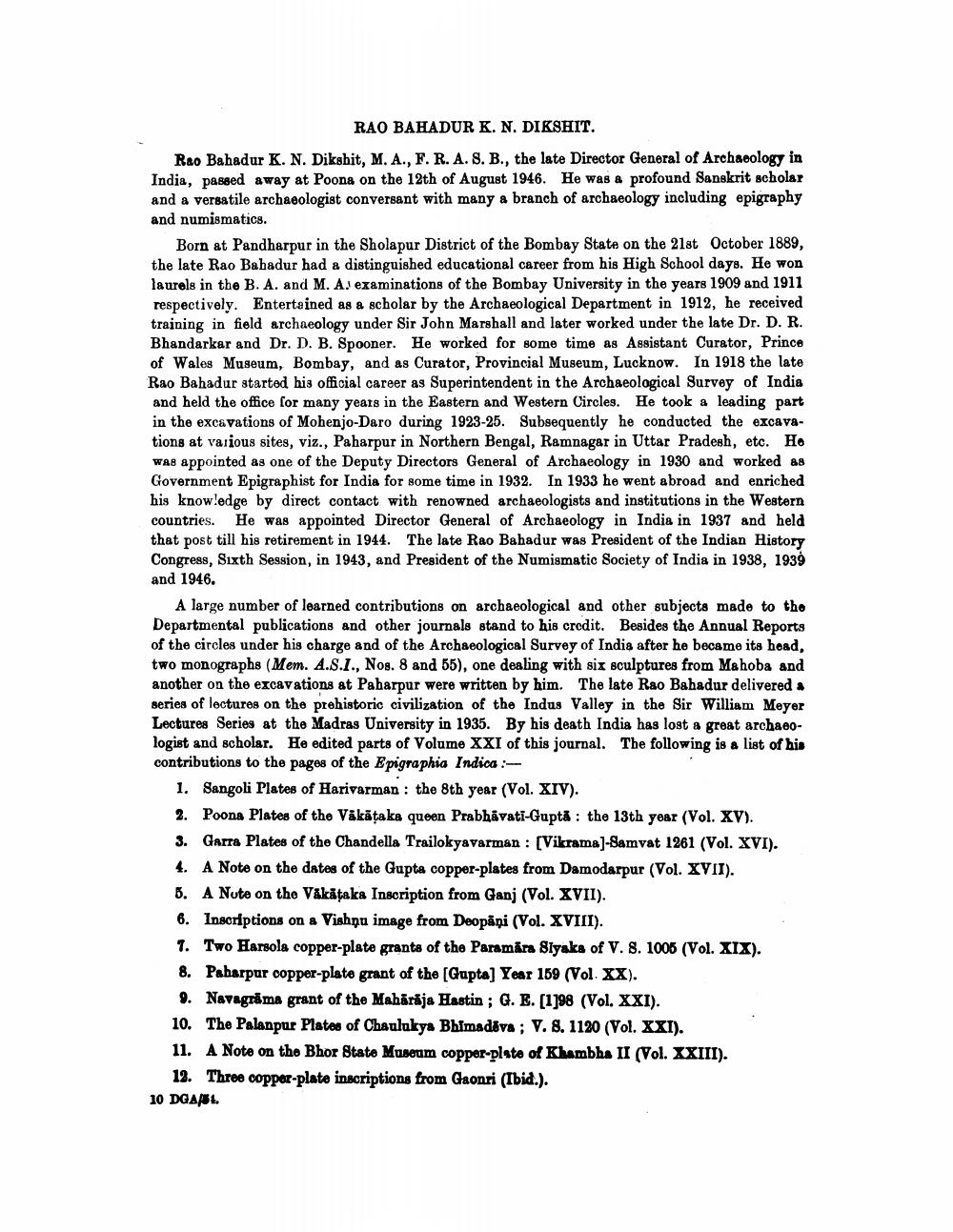________________
RAO BAHADUR K. N. DIKSHIT.
Rao Bahadur K. N. Dikshit, M.A., F. R. A. S. B., the late Director General of Archaeology in India, passed away at Poona on the 12th of August 1946. He was a profound Sanskrit scholar and a versatile archaeologist conversant with many a branch of archaeology including epigraphy and numismatics.
Born at Pandharpur in the Sholapur District of the Bombay State on the 21st October 1889, the late Rao Bahadur had a distinguished educational career from his High School days. He won laurels in the B. A. and M. A. examinations of the Bombay University in the years 1909 and 1911 respectively. Entertained as a scholar by the Archaeological Department in 1912, he received training in field archaeology under Sir John Marshall and later worked under the late Dr. D. R. Bhandarkar and Dr. D. B. Spooner. He worked for some time as Assistant Curator, Prince of Wales Museum, Bombay, and as Curator, Provincial Museum, Lucknow. In 1918 the late Rao Bahadur started his official career as Superintendent in the Archaeological Survey of India and held the office for many years in the Eastern and Western Circles. He took a leading part in the excavations of Mohenjo Daro during 1923-25. Subsequently he conducted the excavations at various sites, viz., Paharpur in Northern Bengal, Ramnagar in Uttar Pradesh, etc. Ho was appointed as one of the Deputy Directors General of Archaeology in 1930 and worked as Government Epigraphist for India for some time in 1932. In 1933 he went abroad and enriched his knowledge by direct contact with renowned archaeologists and institutions in the Western countries. He was appointed Director General of Archaeology in India in 1937 and held that post till his retirement in 1944. The late Rao Bahadur was President of the Indian History Congress, Sixth Session, in 1943, and President of the Numismatic Society of India in 1938, 1939 and 1946.
A large number of learned contributions on archaeological and other subjects made to the Departmental publications and other journals stand to his credit. Besides the Annual Reports of the circles under his charge and of the Archaeological Survey of India after he became its head, two monographs (Mem. A.S.I., Nog. 8 and 55), one dealing with six sculptures from Mahoba and another on the excavations at Paharpur were written by him. The late Rao Bahadur delivered a series of lectures on the prehistoric civilization of the Indus Valley in the Sir William Meyer Lectures Series at the Madras University in 1935. By his death India has lost a great archaeologist and scholar. He edited parts of Volume XXI of this journal. The following is a list of his contributions to the pages of the Epigraphia Indica :
1. Sangoli Plates of Harivarman : the 8th year (Vol. XIV). 2. Poona Plates of the Vikātake queen Prabhāvati-Guptă : the 13th year (Vol. XV). 3. Garra Plates of the Chandella Trailokyavarman : (Vikrama]-Samvat 1261 (Vol. XVI). 4. A Note on the dates of the Gupta copper-plates from Damodarpur (Vol. XVII). B. A Nuto on the Vákäțaka Inscription from Ganj (Vol. XVII). 6. Inscriptions on a Vishnu image from Deopäni (Vol. XVIII). 1. Two Harsola copper-plate grants of the Paramära Slyaka of V. 8. 1006 (Vol. XIX). 8. Pabarpur copper-plate grant of the [Gupta] Year 159 (Vol. XX). 4. Navagrāma grant of the Mahārāja Hastin ; G. E. (1398 (Vol. XXI). 10. The Palanpur Plates of Chaulukya Bhimadova ; V. 8. 1120 (Vol. XXI). 11. A Note on the Bhor State Museum copper-plate of Khambha II (Vol. XXIII).
12. Three copper-plate inscriptions from Gaonri (Ibid.). 10 DGAAL.




